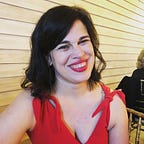Motion Design: Taking a Scene from Wynonna Earp and Turning it Into Kinetic Type
When trying to source a one-minute clip for our type in motion assignment my mind went to one place: television. I’ve been a writer and editor at Tell-Tale TV for the last five years and I have spent a lot of time looking at television shows and how scenes are constructed.
My previous beats have included Blindspot, Killing Eve, The Crown, Resident Alien, and Good Girls. I had been looking at the art of the title sequence for years, and have been dying to play with an assignment like this.
One show that I am absolutely obsessed with at the moment is Wynonna Earp, it’s a Canadian show that is currently looking for a new home. The season finale aired on Friday, April 9th and it was an emotional one for all the characters.
Finding Source Content
I tried to think of scenes that would be fun to animate and a few immediately came to mind.
- Waverly’s Entrance: The first time viewers meet the main character’s sister she breaks down a door and almost shoots Wynonna. It’s an interesting tone shift and comes in at around 50 seconds.
- The Couch Scene: Most of the dialogue here takes place between the ten-second mark and the 1:10 mark. It would be exactly one minute, but it would also mean cutting a portion of it for time, not sure how I would manage the fade in and fade out in Adobe Audition. Pros, only two speakers.
- Ring in a Biscuit: Approximately 30-second clip with three speakers. It’s a little less dialogue but with more interruptions, and three speakers.
After watching each of these clips several times I settled on the couch scene as my subject matter, but since it was long, I had to load it into Adobe Audition.
I opted to cut it before Waverly says, “You know what I’ve always wanted,” and leave Nicole’s “Oh, I’m sure you do,” as the last line. I used audio selection to delete extraneous audio and then adjusted the fades so the transition was smoother.
While I was editing, I did save a longer version for myself for later expansion that has all the dialogue after this project concludes.
Transcription and Lots of Listening
My next step was to transcribe the scene. Since I also imagined this document would have notes on effects I was thinking about using, and how the text should appear I made a Google Sheet to make sure I had it all sorted out.
When I formatted the transcript I tried to hit enter every time there was some sort of pause. Listening to the audio over and over again I was able to tell when I would need a longer pause or when the character was really emphasizing a certain word.
What I hadn’t considered was the music kicking in, some of the lyrics are audible so I typed out where they were in the spreadsheet to to make sure I considered including them even with low contrast as some form of ambiance.
At this time, I also began watching a lot of the kinetic-type resources in the assignment brief to try and get a sense of the type of effects that were possible and to give me some ideas as to what and how I would want the type to look to convey the emotions between the characters.
Animatic Research
I found a few animatic videos in the past that I really liked watching, and so I sought out the artists on YouTube to see if they’d created any tutorials on how to make animatics. I ended up watching this video by Art of Rhues.
This deals with animation and illustration and it’s not exactly what I want we needed to do but it was a good starting point.
So then I decided to try looking for kinetic type animatics and I found these examples which were helpful in letting me figure out what I needed to convey in the storyboard.
Moodboard
In between bouts of listening I decided to put together a mood board. Since Wynonna Earp already has a brand and has used kinetic type pretty well in TV spots, I decided to assemble some examples that I could refer to and use that to try to think of some color palettes.
I also thought thisb would be a good way to collect types of fonts that I liked as I tried to figure out how I would distinguish the two character’s identities.
Storyboarding
I decided to create my storyboard in Illustrator after realizing there were probably multiple transitions and setups I would want to do with this audio. I made rough frames of the entire minute, coming in at 85 frames.
I am not really a fan of the type I chose for this version, but I think the number of iterations and frames will make for a very thorough animatic and will allow me to adjust when I get into After Effects. This is especially important since when I started laying this out I realized just how chaotic this scene actually is.
I don't regret choosing it, but I am glad that I went deep with the storyboarding, even if I didn’t commit to color in this round, again.
One thing I may consider adding is the lyrics to the song, since they are pretty clear and tend to come between dialogue. I think there is potential to be creative there, and add them in an unobtrusive way, but I am prioritizing the dialogue at the moment.
Drive link with audio, full-size storyboard JPEGS, and a link to a Google Sheet
